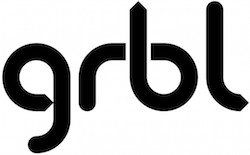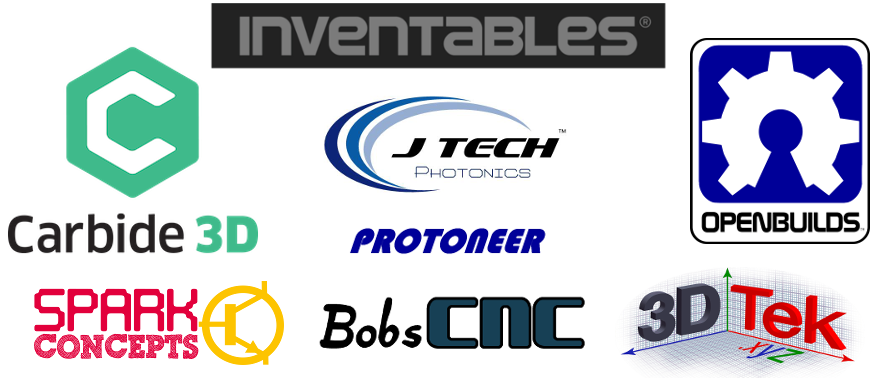 grbl
grbl
An open source, embedded, high performance g-code-parser and CNC milling controller written in optimized C that will run on a straight Arduino
Top Related Projects
An open source, embedded, high performance g-code-parser and CNC milling controller written in optimized C that will run on a straight Arduino
A port of Grbl CNC Firmware for ESP32
Marlin is an optimized firmware for RepRap 3D printers based on the Arduino platform. Many commercial 3D printers come with Marlin installed. Check with your vendor if you need source code for your specific machine.
A cross-platform G-Code sender for GRBL, Smoothieware, TinyG and G2core.
Quick Overview
GRBL is an open-source, high-performance CNC motion control software for Arduino-based microcontrollers. It interprets G-code commands and controls stepper motors to move CNC machines with precision. GRBL is widely used in DIY and small-scale CNC projects due to its reliability and efficiency.
Pros
- Lightweight and efficient, capable of running on low-cost Arduino hardware
- Supports a wide range of CNC machines, including 3D printers, laser cutters, and milling machines
- Active community support and continuous development
- Highly configurable and customizable for various machine setups
Cons
- Limited to 3-axis control in the core version (though extensions exist for more axes)
- Requires some technical knowledge to set up and configure properly
- May not be suitable for large-scale industrial CNC applications
- Limited built-in safety features compared to commercial CNC controllers
Code Examples
Since GRBL is firmware for Arduino-based microcontrollers, there aren't typical code examples to show. However, here are some G-code examples that GRBL interprets:
G0 X10 Y20 Z5
This moves the machine rapidly to the position X=10, Y=20, Z=5.
G1 X50 Y60 F1000
This performs a linear move to X=50, Y=60 at a feed rate of 1000 units per minute.
M3 S1000
This starts the spindle clockwise at 1000 RPM.
Getting Started
To get started with GRBL:
- Download the latest GRBL firmware from the GitHub repository.
- Flash the firmware to your Arduino-compatible board using the Arduino IDE.
- Connect your board to your CNC machine's stepper drivers and limit switches.
- Use a G-code sender program (like Universal G-code Sender) to communicate with GRBL.
- Configure GRBL settings using
$commands (e.g.,$100=800.000to set X-axis steps/mm). - Send G-code commands to control your CNC machine.
For detailed instructions, refer to the GRBL wiki on the GitHub repository.
Competitor Comparisons
An open source, embedded, high performance g-code-parser and CNC milling controller written in optimized C that will run on a straight Arduino
Pros of gnea/grbl
- More active development and maintenance
- Enhanced features and improvements over the original
- Better documentation and community support
Cons of gnea/grbl
- Potential compatibility issues with older hardware
- Steeper learning curve for new users
- May require more system resources
Code Comparison
grbl:
void stepper_init() {
// Configure step and direction interface pins
STEP_DDR |= STEP_MASK;
STEPPERS_DISABLE_DDR |= 1<<STEPPERS_DISABLE_BIT;
}
gnea/grbl:
void stepper_init()
{
// Configure step and direction interface pins
STEP_PORT_DDR |= STEP_MASK;
STEPPERS_DISABLE_PORT_DDR |= (1<<STEPPERS_DISABLE_BIT);
// Configure Timer 1 for stepper driver interrupt
TCCR1B &= ~(1<<WGM13); // CTC mode
TCCR1B |= (1<<WGM12);
}
The gnea/grbl version includes additional configuration for Timer 1, which is used for the stepper driver interrupt. This demonstrates the enhanced features and improvements in the forked version.
A port of Grbl CNC Firmware for ESP32
Pros of Grbl_Esp32
- Built on ESP32 microcontroller, offering Wi-Fi and Bluetooth connectivity
- Supports more axes (up to 6) and additional features like servo control
- Utilizes the ESP32's dual-core processor for improved performance
Cons of Grbl_Esp32
- More complex setup and configuration due to additional features
- May require more power and have higher hardware costs
- Potentially less stable due to increased complexity and newer codebase
Code Comparison
Grbl (Arduino-based):
void mc_line(float *target, plan_line_data_t *pl_data)
{
// [... existing code ...]
plan_buffer_line(target, pl_data);
}
Grbl_Esp32:
void mc_line(float* target, plan_line_data_t* pl_data, float* position)
{
// [... existing code ...]
plan_buffer_line(target, pl_data, position);
}
The Grbl_Esp32 version includes an additional position parameter, allowing for more precise control and tracking of the machine's current position.
Marlin is an optimized firmware for RepRap 3D printers based on the Arduino platform. Many commercial 3D printers come with Marlin installed. Check with your vendor if you need source code for your specific machine.
Pros of Marlin
- More feature-rich, supporting a wider range of 3D printer configurations and add-ons
- Better suited for complex 3D printing tasks with advanced temperature control and bed leveling
- Larger community and more frequent updates
Cons of Marlin
- Higher resource requirements, may not run well on lower-end microcontrollers
- More complex configuration process due to extensive feature set
- Steeper learning curve for beginners
Code Comparison
Marlin (configuration example):
#define BAUDRATE 250000
#define MOTHERBOARD BOARD_RAMPS_14_EFB
#define X_DRIVER_TYPE A4988
#define Y_DRIVER_TYPE A4988
#define Z_DRIVER_TYPE A4988
GRBL (configuration example):
#define BAUD_RATE 115200
#define STEP_PULSE_MICROSECONDS 10
#define STEPPING_INVERT_MASK 0
#define DIRECTION_INVERT_MASK 0
#define STEPPER_IDLE_LOCK_TIME 25
The code snippets show configuration differences, with Marlin focusing on board and driver setup, while GRBL emphasizes motion control parameters. Marlin's configuration is more extensive due to its broader feature set, while GRBL's is more streamlined for CNC applications.
A cross-platform G-Code sender for GRBL, Smoothieware, TinyG and G2core.
Pros of Universal-G-Code-Sender
- User-friendly graphical interface for sending G-code commands
- Cross-platform compatibility (Windows, macOS, Linux)
- Supports various CNC controllers, not limited to GRBL
Cons of Universal-G-Code-Sender
- Larger file size and resource usage compared to GRBL
- May have a steeper learning curve for users new to CNC software
Code Comparison
GRBL (firmware):
void mc_line(float *target, plan_line_data_t *pl_data)
{
// Generate step events for linear motion
uint8_t idx;
for (idx=0; idx<N_AXIS; idx++) {
// Calculate target position in absolute steps
target[idx] *= settings.steps_per_mm[idx];
Universal-G-Code-Sender (Java application):
public void sendGcodeCommand(String command) {
if (this.isConnected()) {
try {
this.sendMessageToConsole(command + "\n");
this.connection.sendStringToComm(command + "\n");
} catch (Exception e) {
The code snippets highlight the different focuses of the projects. GRBL is a firmware that directly controls CNC machine movements, while Universal-G-Code-Sender is a user interface application for sending commands to CNC controllers.
Convert  designs to code with AI
designs to code with AI

Introducing Visual Copilot: A new AI model to turn Figma designs to high quality code using your components.
Try Visual CopilotREADME

Grbl v1.1 has been released here!
Notice: This site will be phased out and moved to the new one!
Grbl is a no-compromise, high performance, low cost alternative to parallel-port-based motion control for CNC milling. It will run on a vanilla Arduino (Duemillanove/Uno) as long as it sports an Atmega 328.
The controller is written in highly optimized C utilizing every clever feature of the AVR-chips to achieve precise timing and asynchronous operation. It is able to maintain up to 30kHz of stable, jitter free control pulses.
It accepts standards-compliant g-code and has been tested with the output of several CAM tools with no problems. Arcs, circles and helical motion are fully supported, as well as, all other primary g-code commands. Macro functions, variables, and most canned cycles are not supported, but we think GUIs can do a much better job at translating them into straight g-code anyhow.
Grbl includes full acceleration management with look ahead. That means the controller will look up to 18 motions into the future and plan its velocities ahead to deliver smooth acceleration and jerk-free cornering.
-
Licensing: Grbl is free software, released under the GPLv3 license.
-
For more information and help, check out our Wiki pages! If you find that the information is out-dated, please to help us keep it updated by editing it or notifying our community! Thanks!
-
Lead Developer [2011 - Current]: Sungeun(Sonny) K. Jeon, Ph.D. (USA) aka @chamnit
-
Lead Developer [2009 - 2011]: Simen Svale Skogsrud (Norway). aka The Originator/Creator/Pioneer/Father of Grbl.
Official Supporters of the Grbl CNC Project

Master Branch:
- Grbl v0.9j Atmega328p 16mhz 115200baud with generic defaults (2016-03-17)
- IMPORTANT INFO WHEN UPGRADING TO GRBL v0.9 :
- Baudrate is now 115200 (Up from 9600).
- Homing cycle updated. Located based on switch trigger, rather than release point.
- Variable spindle is now enabled by default. Z-limit(D12) and spindle enable(D11) have switched to access the hardware PWM on D11. Homing will not work if you do not re-wire your Z-limit switch to D12.
Archives:
- Grbl v0.9i Atmega328p 16mhz 115200baud with generic defaults
- Grbl v0.9g Atmega328p 16mhz 115200baud with generic defaults
- Grbl v0.8c Atmega328p 16mhz 9600baud
- Grbl v0.7d Atmega328p 16mhz 9600baud
- Grbl v0.6b Atmega328p 16mhz 9600baud
- Grbl v0.51 Atmega328p 16mhz 9600baud
- Grbl v0.6b Atmega168 16mhz 9600baud
- Grbl v0.51 Atmega168 16mhz 9600baud
Update Summary for v0.9j
- Restore EEPROM feature: A new set of restore EEPROM features to help OEMs and users reset their Grbl installation to the build defaults. See Configuring Grbl Wiki for details.
- More configuration options for input pins
- Bug fixes including: Soft limit error handling, disable spindle when S0, g-code reporting of G38.x.
Update Summary for v0.9i
- IMPORTANT:
- Homing cycle updated. Locates based on trigger point, rather than release point.
- System tweaks: $14 cycle auto-start has been removed. No more QUEUE state.
- New G-Codes
- CoreXY Support
- Safety Door Support
- Full Limit and Control Pin Configurability
- Additional Compile-Time Feature Options
Update Summary for v0.9h from v0.8
-
IMPORTANT:
- Default serial baudrate is now 115200! (Up from 9600)
- Z-limit(D12) and spindle enable(D11) pins have switched to support variable spindle!
-
Super Smooth Stepper Algorithm
-
Stability and Robustness Updates
-
(x4)+ Faster Planner
-
Compile-able via Arduino IDE!
-
G-Code Parser Overhaul
-
Independent Acceleration and Velocity Settings
-
Soft Limits
-
Probing
-
Dynamic Tool Length Offsets
-
Improved Arc Performance
-
CPU Pin Mapping
-
New Grbl SIMULATOR! (by @jgeisler and @ashelly)
-
Configurable Real-time Status Reporting
-
Updated Homing Routine
-
Optional Limit Pin Sharing
-
Optional Variable Spindle Speed Output
-
Additional Compile-Time Feature Options
List of Supported G-Codes in Grbl v0.9 Master:
- Non-Modal Commands: G4, G10L2, G10L20, G28, G30, G28.1, G30.1, G53, G92, G92.1
- Motion Modes: G0, G1, G2, G3, G38.2, G38.3, G38.4, G38.5, G80
- Feed Rate Modes: G93, G94
- Unit Modes: G20, G21
- Distance Modes: G90, G91
- Arc IJK Distance Modes: G91.1
- Plane Select Modes: G17, G18, G19
- Tool Length Offset Modes: G43.1, G49
- Cutter Compensation Modes: G40
- Coordinate System Modes: G54, G55, G56, G57, G58, G59
- Control Modes: G61
- Program Flow: M0, M1, M2, M30*
- Coolant Control: M7*, M8, M9
- Spindle Control: M3, M4, M5
- Valid Non-Command Words: F, I, J, K, L, N, P, R, S, T, X, Y, Z
Top Related Projects
An open source, embedded, high performance g-code-parser and CNC milling controller written in optimized C that will run on a straight Arduino
A port of Grbl CNC Firmware for ESP32
Marlin is an optimized firmware for RepRap 3D printers based on the Arduino platform. Many commercial 3D printers come with Marlin installed. Check with your vendor if you need source code for your specific machine.
A cross-platform G-Code sender for GRBL, Smoothieware, TinyG and G2core.
Convert  designs to code with AI
designs to code with AI

Introducing Visual Copilot: A new AI model to turn Figma designs to high quality code using your components.
Try Visual Copilot